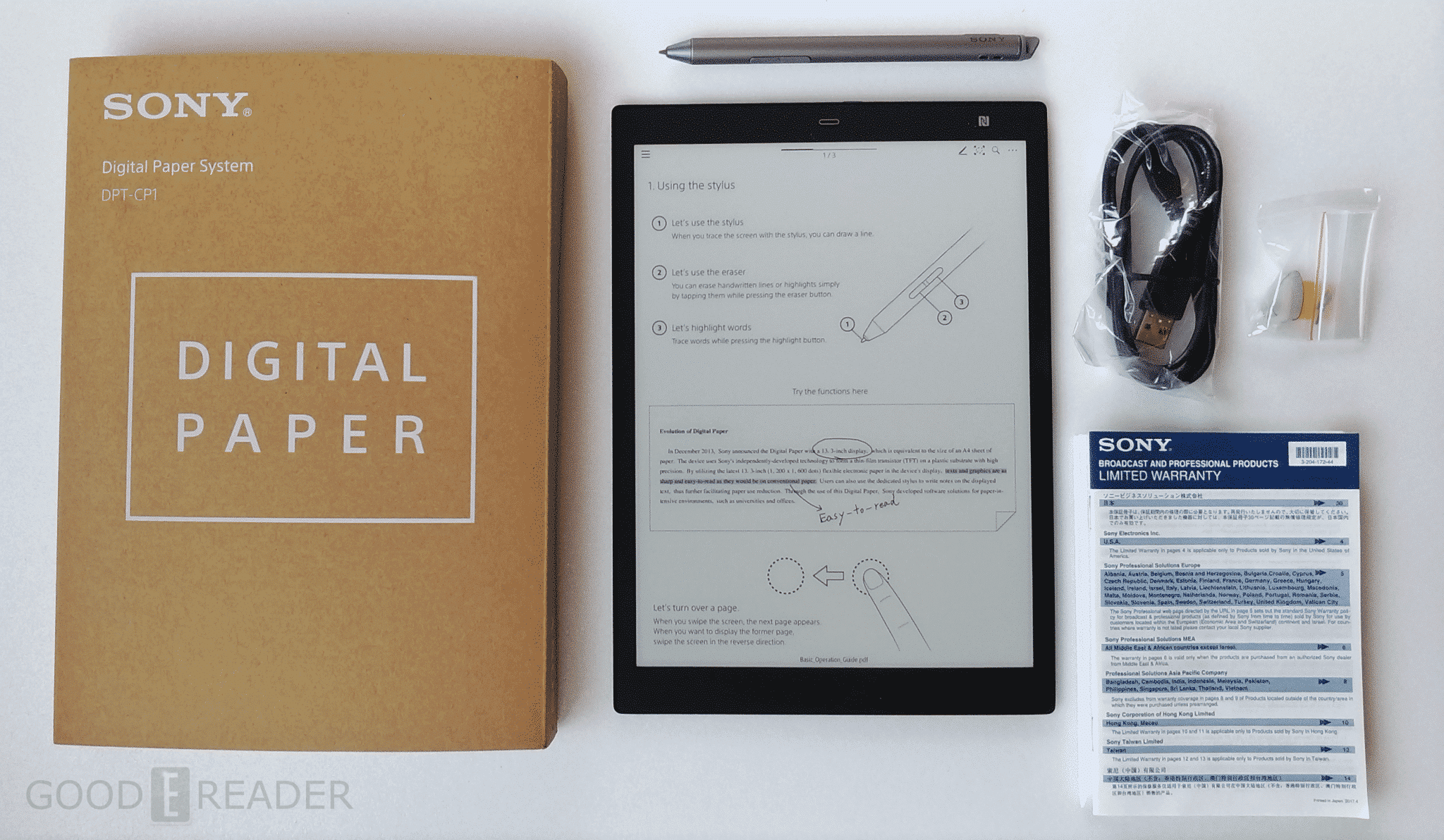Sony has a storied history in the e-reader and e-note space. They released a series of e-readers before Amazon, Barnes and Noble and Kobo ever got into the business.. They were also the ones that developed LED lights on e-readers. They also pioneered the concept of e-notes, which are digital note taking devices that you can freehand draw, take notes or edit PDF documents. You could say, if it weren’t for Sont, the e-reader landscape would be completely different. Good e-Reader is pleased to unveil our first documentary, where we look at the entire history of Sony in the e-reader and e-note space and where they are today.
Sony opened up their first eBookstore in 2004 and was selling e-Readers long before Amazon released their first generation Kindle in 2007. As the e-reader market matured and many new entrants developed their own devices and started selling digital books, such as Apple, Google, B&N and Kobo. Due to the increased pressure and diminishing revenue, Sony decided to kill off their e-reader business in 2014 and also shuttered their digital bookstore. Although they stopped making consumer e-readers, they developed a large screen e-note that could read A4 documents. This kickstarted the entire e-note industry, which is still going strong today. In 2020, Sony decide to get out of the e-note business, since this too was being hypercompetitive. They decided to focus their efforts on OEM models and helping out other companies to use their technology. They started a partnership with E INK called Linfiny, and devices stared to be licensed to Fujitssu Quaderno, Quirklogic Papyr, Dasung A4 and many others.
There is a long storied history of Sony being involved in the e-Reader sector and they released more models than anyone in the entire industry. Today we look at the evolution of the Sony brand, from the first device, until their last. Incidentally, if you like this evolution piece, check out the ones we did on Amazon and Kobo.
Sony Librie

The Sony Librie was otherwise known as the EBR-100EP and was originally released in April 2004. It was the very first commercial e-ink device, and was sold only in Japan, but many devices were sold in the US through online retailers and with a third-party English OS upgrade. This reader was the result of a three-year collaboration between Sony, Philips, Toppan printing and E Ink Corporation.
The resolution was 800×600, which was amazing at the time and many modern e-readers still adhere to this old standard. People were surprised this could hold over 10 books with the 10MB of storage and were able to listen to music and audiobooks via the speaker and headphone jack.
The Librie was interesting historically because Sony developed their own proprietary eBook format, LRF. This model basically only read books that were purchased from the Sony Japanese book store and had no support for PDF or other popular formats at the time, such as Microsofts, Nokia, or Palm.
Sony PRS-500

The Sony PRS-500 was known as “A Reader” in their promotional and marketing campaign. This was the first device that Sony marketed outside Japan and was released in September 2006. This was one year before Amazon unveiled their own Kindle reader.
Sony streamlined this e-reader and discarded the physical keyboard that was on their first device ever made. Instead, they went with a unique controller system that was in essence two joysticks. One was for page turns and the other for accessing the menu, settings or dictionary.
The first Sony reader could only store 10MB of data, and this model was upgraded to hold 64MB, which drastically increased the amount of books that could be loaded on it. No longer were customers forced to delete books they finished reading, but could store over 80.
This reader had the same e-ink screen as the Libri, but had a faster processor. On November 16, 2009, Sony announced that a firmware update is available to support the ePub and Adobe DRM format and add the ability to re-flow PDF documents”. Owners must send the reader into the Sony Service Centers for the updated firmware. You can obviously tell how infant the e-reader industry was during this era, when you had to mail away your e-reader for over a month for them to load in the new firmware for you.
Sony PRS-505

The Sony PRS-505 was originally released in October 2007, the same year Amazon unveiled their first generation Kindle. This model used a new e-Ink Vizplex display screen, which provided faster page turns than the prior models. Although the overall performance was enhanced, Sony still abided by the 800×600 resolution. This also marked the first time that you could charge a Sony reader via the USB cable.
Sony increased the internal storage yet again on this model, which saw a dramatic leap to 256MB and over 500 books available to be stored. Also, adding books to “Collections” (a feature to organize and group book titles) is now possible on the SD card, unlike the PRS-500 model.
July 24, 2008 marked the first time this model received a firmware update to support the fledgling ePub format Adobe Digital Editions 1.5 and Adobe DRM protected PDF files, automatic reflow of PDF files formatted for larger pages enlarges the text to improve readability, and support for high capacity SDHC memory card. This time, instead of sending the reader in to get the update, it was provided as a free download, along with written instructions.
Sony PRS-700

The Sony PRS-700 was a benchmark e-reader and broke the mold on several fronts. It was the first touchscreen e-reader and the first model to feature an illuminated screen to let you read in the dark.
Sony heavily invested in touchscreen technology with their e-readers and this was the first of many to fully adopt it. Moving in this direction eliminated the D-Pad and most keys, minimizing the footprint and making it easier to hold. This was also the first e-reader that allowed you to make highlights, annotations on the fly and take advantage of the new virtual keyboard.
The LED lights on this unit was a precursor to the front-lit technology we see on the modern 2014 readers, such as the Nook Glowlight, Kobo Aura and Kindle Paperwhite 2. It all started with Sony making in-roads and taking the risk of developing technology never seen before on an e-reader. The overall experience was really lacklustre and jaded executives so much that they said they would never make a LED reader ever again.
Sony Touch Edition PRS-600
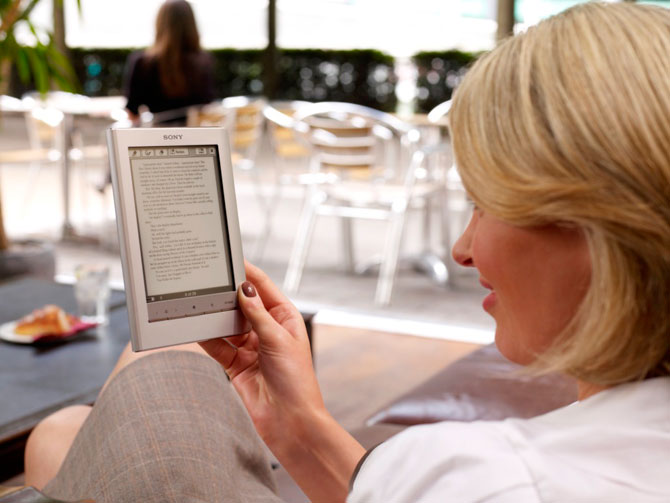
The Sony PRS-600 was known as the Touch Edition and was released the very same day as the five inch Pocket Edition on August 2009. This reader continued the trend of having a speaker and 3.55 headphone jack and relied on the touchscreen as a way to take notes and highlights.
The Touch Edition was the first time Sony marketed their readers in three different colors, black, white and red. This model also increased the storage from 256MB on the prior model to over 512MB. It had the same resolution as the older models, so did not break any new ground on the ePaper front.
Up until the launch of the Touch Edition all Sony e-Readers were unable to read PDF or EPUB files out of the box. You had to either send them to Sony via snail mail for them to manually patch or do it yourself. This was the year that Sony firmly switched over from their own LRF format to EPUB and native PDF support.
The move to firmly embrace EPUB and PDF allowed a new generation of users to be able to not exclusively shop at Sony anymore for their books. Instead, they could deal with other retailers and use Adobe Digital Editions to sync up the purchases.
This was the first e-reader that Sony really stepped their marketing efforts on. They made a number of stock images for bloggers to use in their writeups and started blitz campaigns in the Sony Style stores and also expanded their retail distribution into countries like Canada.
Pocket Edition PRS-300
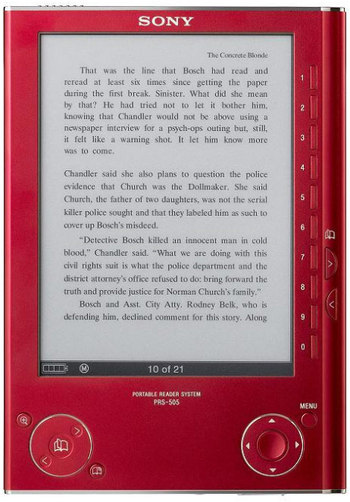
The Sony Pocket Edition was released on August 2009, the same day as the PRS-600. Sony went back to their roots by offering an entry level reader for a solid $199, which made it one of the cheapest models at this point in time.
One of the ways Sony saved many was abandoning the costly touchscreen technology and instead went with physical page turn keys, D-Pad and manual page turn buttons. It also had no MP3 audio or expandable memory. It has a similar interface to the PRS-500 and PRS-505.
Sony Daily Edition PRS-900
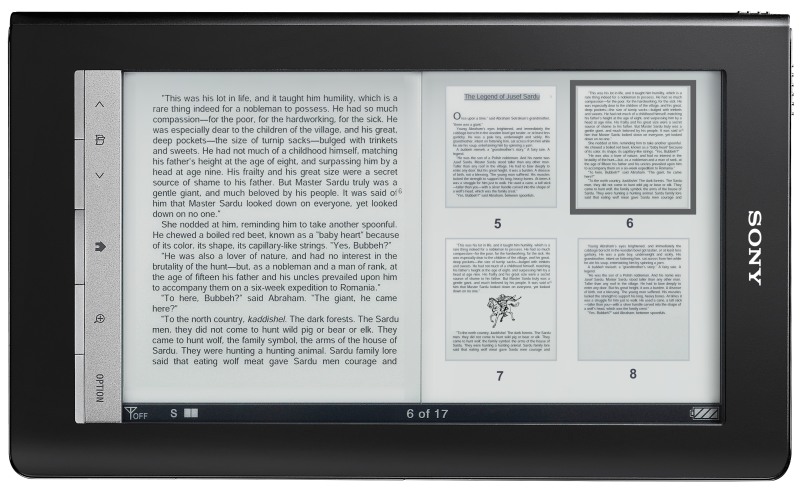
When the Sony Daily PRS-900 was first unveiled in December 2009 it bucked the trend of the standard six inch device and incorporated a 7 inch screen. Sony also borrowed a page out of Amazons playbook and offered free 3G internet access to the US version of the Sony bookstore.
Sony increased the memory yet again to a whopping 2GB, which allowed over 1700 books to loaded on it. It also boosted up the resolution, making it the best on the market at this time. It had 1024×600, which was ideal for reading texts in landscape or portrait mode.
The Daily Edition was the first time there were no hardware buttons at all. It was completely reliant on the touchscreen and Stylus for all of your inputs. 2009 was a big year for Sony with 3 new devices hitting the market months within each other.
This model was really expensive and set you back US$399 at the time of release. This was mainly to offset the costs in the internet access, which at the time was a pricey value proposition. It was considered to be the very best e-reader on the market and was more accessible than Amazon.
Setting The Stage for the Next Generation
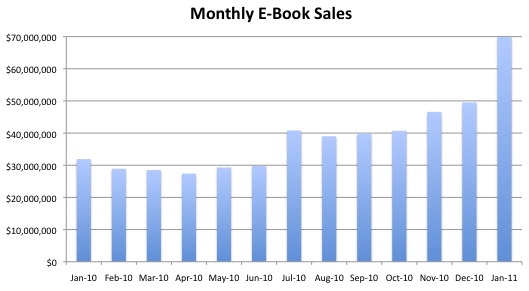
August the 10th 2010 was a milestone for Sony as they released the second generation Pocket Edition, Touch Edition and Daily Edition. The company really refined all of their technology and this lineup of devices was at the height of the e-reader and eBook boom period.
2010 was the year that competition really started to heat up between Amazon, Barnes and Noble and Kobo. E-Ink, the Taiwan company responsible for all of the e-paper displays made over 3 billion in this year alone and even NEONODE, the company responsible for the IR touchscreen tech was making millions.
Sony used their advanced e-readers as an avenue for growth. They opened up online bookstores in the UK, Europe and Australia. All of these models were highly visible in the retail sector, but it was costly. Australians were paying almost 2x the retail cost in North America and most flocked to eBay or other online merchants to save a bundle.
This was the final year that e-Reader revenue was expanding at a geometric rate and it started to decrease in the following years. This was also the last year Sony released three new devices annually and only did one, focusing their efforts on the more lucrative smartphone and tablet market.
Sony Pocket Edition PRS-350
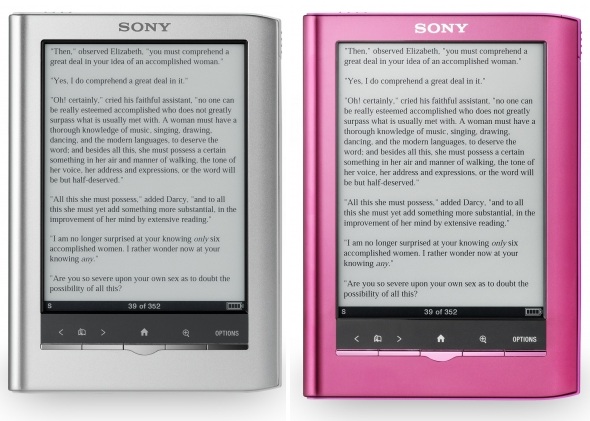
The second generation Pocket Edition was launched on August 2010. This was the first modern line of Sony readers to adopt E-Ink Pearl, which provided a better experience than the antiquated Vizplex technology.
The Pocket Edition continued to be Sony’s smallest ever Reader, clocking in at five inches. It hit the market cheaper than the previous PRS-300 at US$179. Unlike the first generation model it incorporated a touch screen, and two GB of Memory but lacked an SD Card Slot and does not support MP3 playback.
Sony PRS-650 Touch Edition
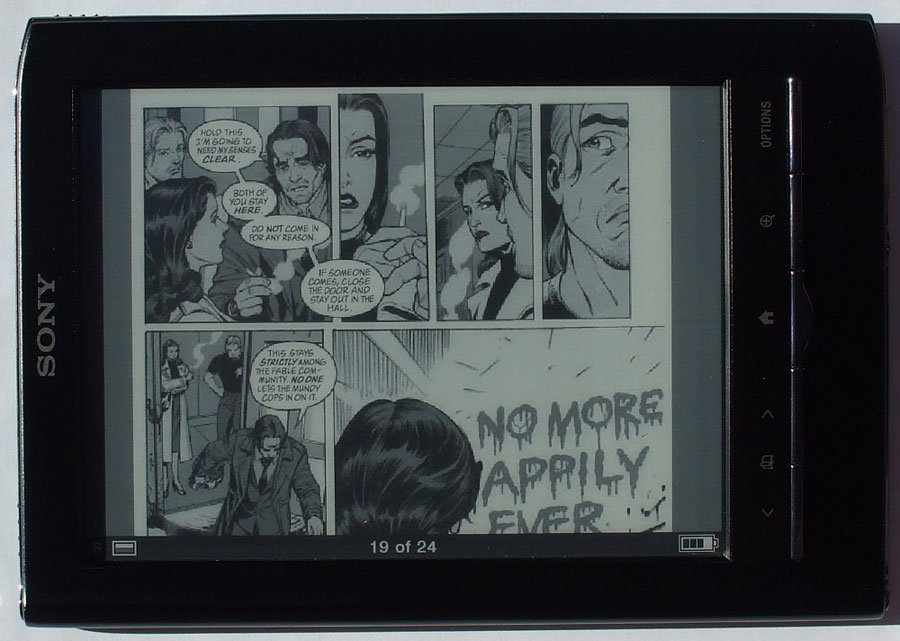
The Sony PRS-650 was released August 2010 and was announced at the same time as the touch-screen PRS-350. It is Sony’s mid-range device, priced at US$229. As the replacement for the PRS-600 model, it is Sony’s higher-scale, touch-screen edition of the reader. It has a similar interface to the PRS-350.
This reader was fully touch screen but brought back physical buttons, such as the settings, options, home and manual page turn keys. The Touch Edition is a compact and lightweight e-book reader; responsive touch-screen interface with no glare or contrast issues; high-contrast E Ink Pearl display; zippier performance than its predecessor; integration with Sony e-book store; good battery life (up to two weeks); supports EPUB e-book standard, which allows for e-book downloads from libraries; audio playback; SD and Memory Stick Duo memory expansion slots.
Sony was unprepared for the Q4 demand for the 650 e-reader. There were a few key reasons why this model in particular is so hard to purchase anywhere in North America, UK, Australia and other countries. Sony in early December recently did a relaunch of their new e-readers in Japan. This was the company’s second attempt to penetrate the often fickle Japanese market. Sony actually diverted shipments from all over the world to Japan, creating an international scarcity.
Sony Daily Edition PRS-950
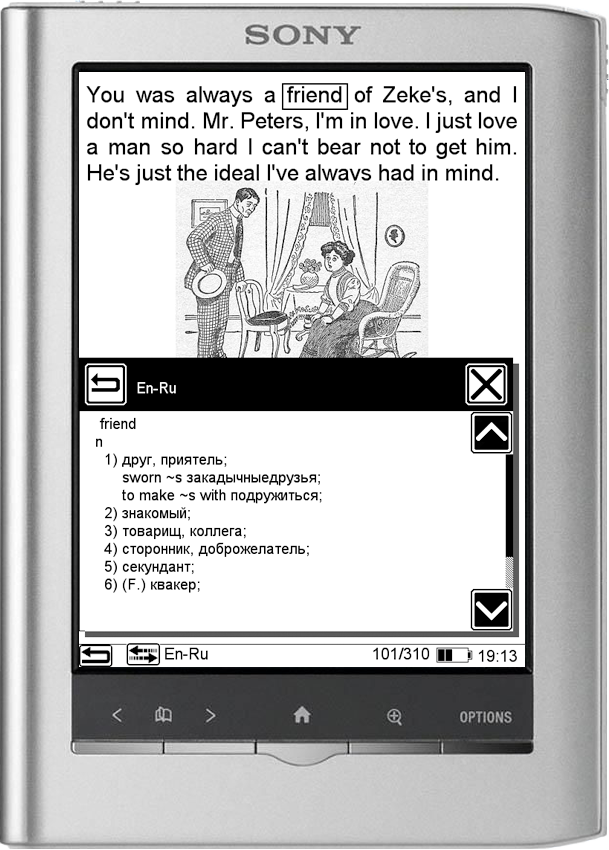
The PRS950 model of the Daily Edition was released August 2010 and adds Wi-Fi to the free 3G wireless access to the Sony eBook store. The Reader Daily Edition features a high contrast E Ink Pearl technology on its anti-glare touch screen. It is otherwise similar to the older PRS 900 model.
This was the last 7 inch model that Sony sold and many users still have this model in 2014. One of the downsides is that the 3G internet has been shut off, because Sony closed their bookstore in North America. The only way to be able to connect up to the internet and use the web-browser is to utilize your personal or public WIFI. It retailed at the time for US$299.
Sony PRS-T1
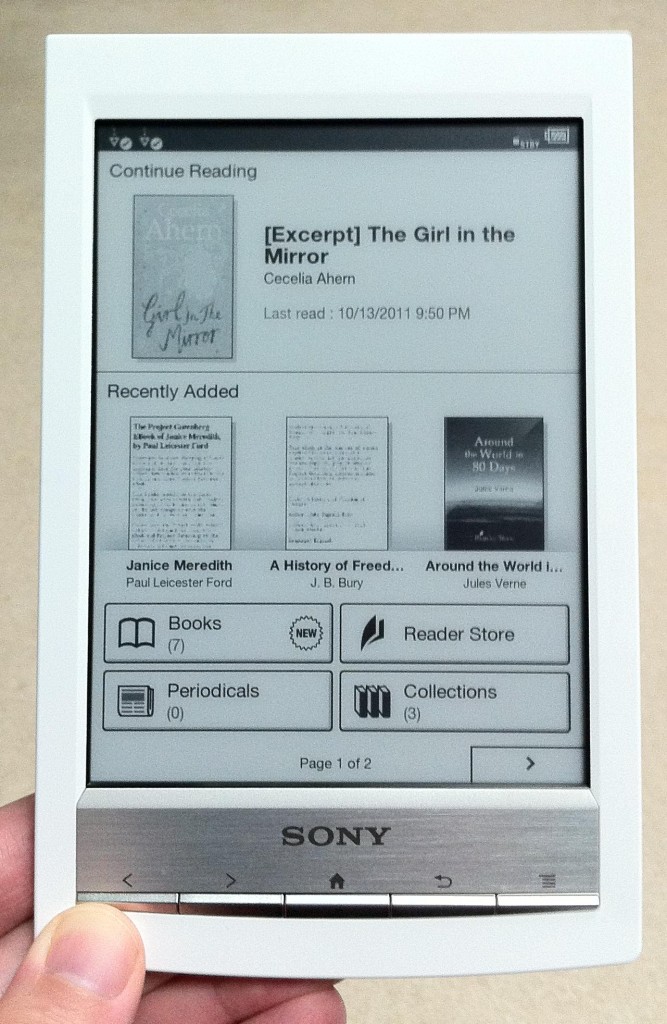
The Sony PRS-T1 came out in October 2011 and marked the first time Sony only released one new e-reader model. The T1 was also known as the Reader Wi-Fi and was billed as the world’s lightest 6″ e-Reader with a glare-free, paper-like display designed for hours of comfortable reading, even in direct sunlight.
The big hyping factor behind the T1 was the new product design, that would shape the next two iterations of the PRS-T product line. It was the first Sony branded device to have built in WIFI to purchase books, magazines and newspapers at Sony Reader Store. Customers could also browse the internet with the built in browser. It also had a built in Overdrive APP, to allow customers to borrow books from the public library.
Sony adhered to the 2GB of memory size, which they found to be enough for your average user. They have also used the same resolution 800×600 that they employed for the last five years.
The T1 was very internationally friendly with 12 Built-in Dictionaries with 2 English and 10 others, such as French, German, Spanish, Dutch and Italian.
Sony PRS-T2
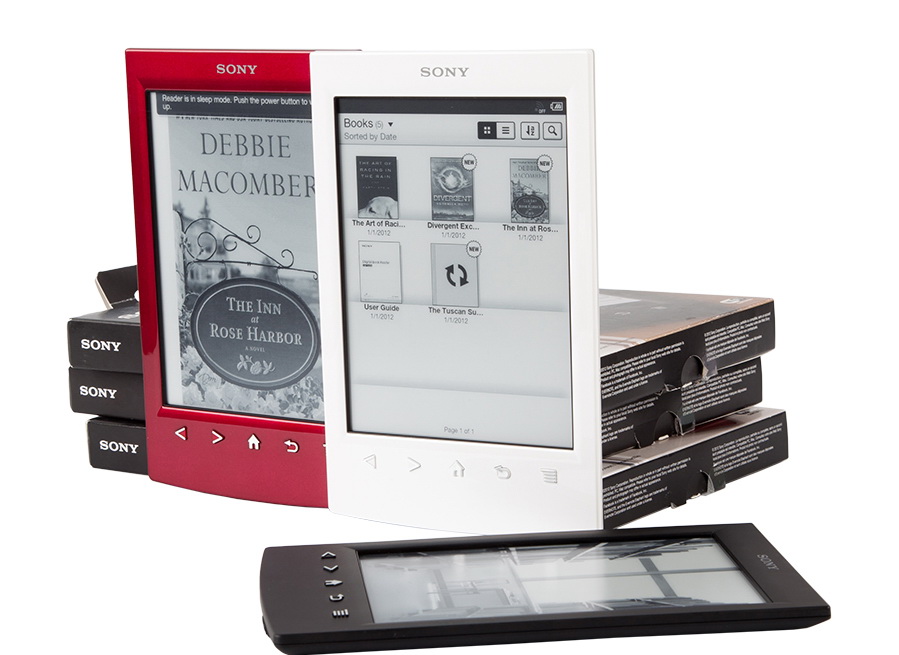
The Sony PRS-T2 was released September 2012 and mirrored the PRS-T1 in almost every single way. One of the most striking differences was the home, settings and manual page turn keys. The T1 had long rectangular buttons, which was a bit unwieldy. The T2 has really small buttons that actually had a ton of torque, it made interacting with them more intuitive and made the device more streamlined.
One of the big deals Sony trumpeted was their business relationship with Evernote. You could save your notes, highlights and annotations directly to your Evernote account, which made students and academics lives a bit easier. The average person really did not care and the T2 update really felt like the iPhone 4 and the 4S, in terms of a very incremental update, not really needed.
Sony PRS-T3
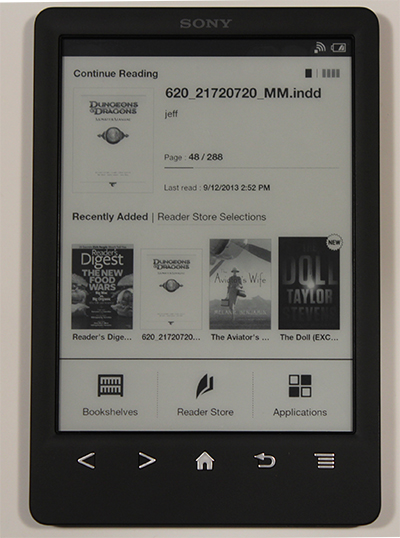
The Sony PRS-T3 was the last consumer e-reader that Sony ever made and was the most successful. The design was streamlined and the page turn buttons were smaller and easier to click on, ditto with the home and back buttons. The Sony T3 was released September 2013 and bypassed the US to be launched in Canada, then the UK, Europe and Australia. This was the first true high-resolution e-readers that mirrored what Amazon, Barnes and Noble and Kobo were doing at the time. 1024×758 is currently the gold standard for e-Reader resolution and it is hard for text to be anymore crisp. Sony sold two different versions of the T3 e-reader line, the second many just came with a case and reading light, it was an extremely limited release, mainly just in Canada.
When Sony discontinued the e-reader a couple of years later, they did a partnership with Kobo. This gave modern Sony users a way to continue to access their old ebooks loaded on the device and purchase new ones. A couple of years after taking over the Sony business, Kobo announced they were no longer supporting it and emailed everyone and begged them to switch over to Kobo.
Sony Digital Paper DPT-S1
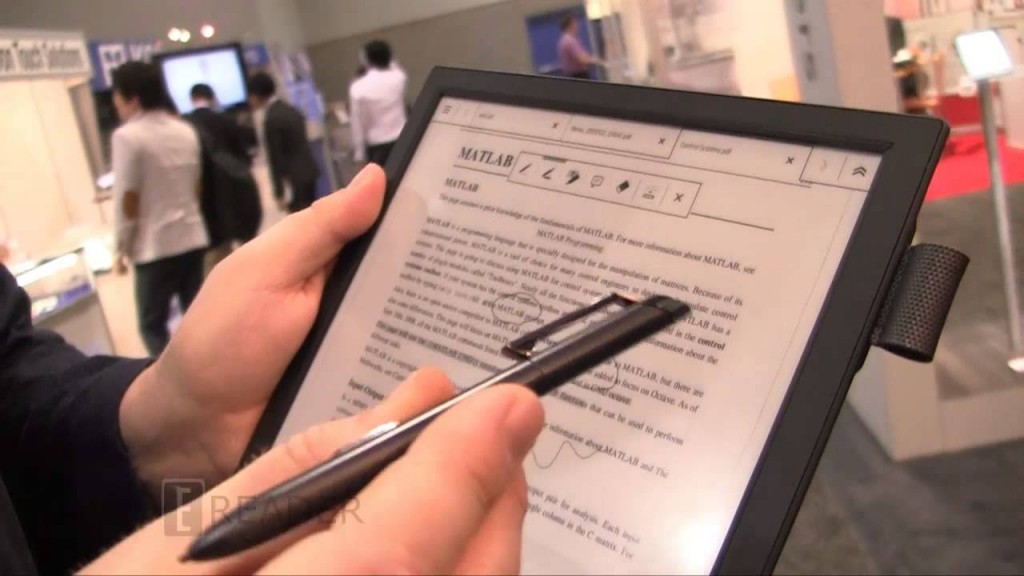
The Sony 13.3 inch e-Reader ushered in a brand new era of high quality e-Paper that allows for a true PDF experience. Sony has exclusivity over this brand new technology called Mobius, which they developed with e-Ink. The screen itself is quite respectable in terms of resolution and pixel density. The resolution on the display is 1200×1600 with 150 PPI. The main attraction is using the active digitizer and interacting with complex PDF documents. You can edit documents by jotting down your own handwritten notes, or even highlight passages to go back to later. You may elect to save your notes as independent files, which makes referencing them in the future easier.
The large screen display will simply give you the best PDF experience you have ever had on an e-reader. When it first launched in Japan, it was easy to buy one, but when it came over to the USA, it was impossible. The distribution of Sony e-notes was left to a new branch of Sony Digital Paper North America. They decided to distribute them to a law firm, entertainments company and few others. It wasn’t until a couple of years later that you could buy through official distributors, including Amazon.
Sony Digital Paper DPT-RP1
In 2017, Sony released their second generation Digital Paper, the DPT-RP1. It switched from a Mobius screen to E INK Carta HD. The DPT-RP1 features a 13.3 inch E-Ink Carta screen with a resolution of 2200 x 1650 and 207 PPI. The screen is completely flush with the bezel and not only does this make the device have a premium feel, it also provides a ton of benefits. You can easily draw edge to edge, which is quite useful for people who are editing a full screen PDF file. Underneath the hood is a Marvell IAP140 64-bit Quad-core IoT Applications Processor and ARM Cortex-A53 CPU, up to 1.2GHz, and has a separate power low-power Cortex M3. It has 1GB of RAM and 16GB of internal memory, but when you power it on the first time, there is 11 GB. The rest is reserved for the Google Android operating system and some of the stock PDF templates that are available.
They also added in a number of security features, such as password protection on specific documents or protecting the entire decide so you can unlock it with a numerical password.
Sony Digital Paper DPT-CP1
The Sony Digital Paper DPT-CP1 is the companies first 10.3 inch model and it is fairly comparable to the 13.3 inch version. It is running the exact same operating system and firmware, so there are no cool little features that make it distinctive. Sony primarily developed this model because they wanted a low cost alternative for businesses, companies or government agencies to go paper free. It was launched in 2018 and was the last e-note that Sony ever developed.
The DPT-Cp1 features an E-Ink Carta display with a resolution of 1872×1404 with 227 PPI. It has a capacitive layer for touchscreen interactions and also one for the stylus to take notes and write on PDF files. Underneath the hood is a Marvell IAP 140 64-bit Quad-core IoT Applications Processor,1GB of RAM, 16GB of internal storage, WIFI and Bluetooth 4.2. The dimensions are 174.2 × 243.5 × 5.9 mm and it weighs approximately 240 g.
You cannot connect up to the internet via WIFI. Instead this connection option is used for connecting up to a PC using the Sony Desktop Software or Sony Digital Paper Mobile Application – Smartphone companion app for Android and IOS for easy, convenient transfer of documents, forms and notes.
Sony discontinued the DPT-RP1 and DPT-CP1 in 2020 and they shuttered their North American division and laid off all of the staff. There was no longer anyway to buy these devices except for Japan. Sony closed their Japanese DPT offices in 2021. Sony, is no longer selling e-readers, or e-notes anywhere in the world. Instead, due to their storied history, they partnered with E INK to form a company called Linfiny. This new company develops, designs and manufactures e-notes. They have not had much success, but they have landed a few big sales, such as Fujitsu.
The post Good e-Reader Documentary – The entire history of Sony e-readers and e-notes first appeared on Good e-Reader.


